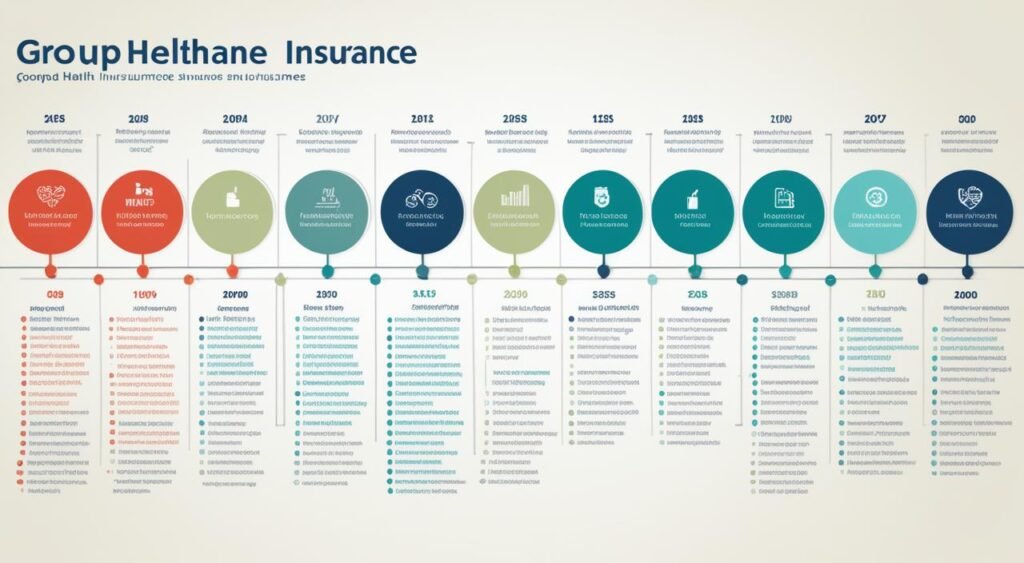Group health insurance is a special kind of health coverage. It’s given by an employer, union, or association to its members who are still working. This type of insurance is different from individual plans because it’s linked to your job. It offers big benefits to both employers and their workers.
A Group Health Plan (GHP) needs at least 70% of its members to take part. It’s also cheaper than individual plans because the risk is shared among more people. Companies with 20 or more workers must give the same health benefits to all workers and their spouses who are 65 or older.
There are different kinds of health insurance plans that count as GHPs. These include plans from small or big employers, self-insured plans, and plans for groups like unions or hours banks. These plans can’t be bought by people on their own. They offer various options to help businesses and their workers.
Key Takeaways
- Group health insurance, or a Group Health Plan (GHP), is health coverage offered by an employer, union, or association to its members while they are still working.
- GHP coverage is based on current employment and typically requires at least 70% participation from the eligible group members.
- The cost of group health insurance is usually much lower than individual plans because the risk is spread across a larger pool of people.
- Employers with 20 or more employees are required by law to offer the same GHP health benefits to current workers and their spouses who are age 65 or older as they do to younger employees.
- Examples of GHPs include small or large employer-sponsored plans, self-insured plans, and employee organizational plans like union plans or hours banks.
Introduction to Group Health Insurance
Group health insurance covers many people at once, like employees or members of a group. It has big benefits for both employers and employees.
Definition and Key Characteristics
Group insurance is for a bunch of people, not just one. It’s cheaper for group members because the risk is shared among them. You can’t buy it on your own and most groups need at least 70% to join.
It’s cheaper than buying insurance alone because it’s shared among more people. This lets members of an organization get group health coverage for less money than going it alone.
“Group health insurance plans provide coverage to a collective group of individuals, typically employees of a company or members of an organization.”
In short, group health insurance is for groups, not just one person. It gives group members cheaper group health plans. It’s a great choice for employers and employees looking for good healthcare at a good price.
How Group Health Insurance Works
Group health insurance plans offer coverage to companies, organizations, and their members or employees. These plans can only be bought by groups, not by individuals. They usually need at least 70% of the eligible group members to join to be valid.
Eligibility and Coverage Criteria
To get a group health insurance plan, you must work for the company or be part of the organization. Your family and dependents can also get coverage, but it might cost more.
Participation Requirements
- Group members can choose to take or leave the health insurance offered by their employer or group.
- The cost of the group health insurance is often shared by the company or organization and its members.
- It’s important to keep at least 70% of the group in the health insurance plan to keep it active.
Knowing about how group health insurance works, eligibility and coverage, and participation requirements helps people and companies pick the right group health insurance plan. This ensures it fits their needs and budget.
Types of Group Health Insurance Plans

Group health insurance plans offer a wide range of coverage options for businesses and their employees. These plans include medical plans and also cover dental, vision, and pharmacy benefits.
Medical plans are key to group health insurance. They cover essential healthcare services. The plans differ in deductibles, copays, and coverage levels to fit various budgets and needs.
Dental and vision insurance are extra protections for employees’ health. They help cover costs for check-ups, treatments, and complex procedures.
Pharmacy benefits make sure employees can get necessary medicines at good prices. This includes coverage for generic and brand-name drugs, and special treatments.
| Plan Type | Coverage Highlights |
|---|---|
| Medical Plans | Inpatient and outpatient care, preventive services, emergency treatment |
| Dental Insurance | Routine check-ups, cleanings, fillings, root canals, orthodontic care |
| Vision Insurance | Eye exams, prescription eyeglasses, contact lenses, corrective surgery |
| Pharmacy Benefits | Prescription drug coverage, including generic and brand-name medications |
The types and levels of coverage in group health insurance vary by provider and group needs. Employers and employees should look at the options carefully. They should pick the right plans for their healthcare needs.
Benefits of Group Health Insurance

Group health insurance plans have many benefits for employers and employees. They help spread risk across many people, keeping premiums low. This way, insurers can better manage risk by understanding the people they cover.
These plans also offer tax advantages for employers and employees. Employers can deduct what they pay for premiums. Employees can pay their premiums before taxes, which can lower their taxable income.
Lower Premiums
Pooling risk is key to lower premiums in group health insurance. By spreading risk over a big group, insurers offer cheaper coverage. This is great for small businesses or individuals who can’t negotiate like big companies.
Tax Benefits for Employers and Employees
Group health insurance also has big tax benefits. Employers can deduct what they pay for employee premiums. This helps cover the cost of these plans. Employees can pay premiums before taxes, which can lower their taxes and save money.
“Group health insurance plans allow employers and employees to take advantage of tax-deductible premium payments, making them a cost-effective solution for managing healthcare costs.”
Group Health Insurance and Medicare
If you have group health insurance through your job, you might not need Medicare Part B at 65. You could get a “Special Enrollment Period” (SEP) to join Part B later without a penalty. This is when your job or health plan ends.
You can join Medicare Part B while you’re under an employer or union health plan. You can also sign up within 8 months after your job or health plan ends. This is whichever comes first.
Special Enrollment Period for Medicare Part B
The special enrollment period for Medicare Part B helps you avoid late penalties. You can sign up during certain times:
- You’re still working and have an employer or union health plan.
- Your employer or union health plan ends.
This period gives you 8 months to join Medicare Part B without a penalty.
| Scenario | Enrollment Period | Penalty Avoidance |
|---|---|---|
| Covered by employer or union GHP based on current employment | Anytime while covered | No late enrollment penalty |
| Employment or GHP coverage ends | Within 8 months after coverage ends | No late enrollment penalty |
Knowing about the special enrollment period for Medicare Part B is key if you have employer or union health insurance. This info helps you avoid penalties and smoothly move to Medicare.
History and Evolution of Group Health Insurance

The history of group health insurance in the United States goes way back to the late 1700s. In 1798, the U.S. Congress set up the Marine Hospital Service. This was one of the first times group health insurance was offered.
By the 19th century, group health insurance started to grow in industries like mining, lumber, and railroads. Montgomery Ward, a big retail company, played a key role. They started the nation’s first group health insurance policy in 1910. This move helped employer-sponsored group coverage grow quickly.
During World War II, group health insurance became more popular. Employers offered these benefits to keep workers during wage controls. After the war, the Social Security Amendments of 1965 helped create Medicare and Medicaid. These programs focused on healthcare for retirees and others who weren’t working.
Many factors have influenced the growth of group health insurance. From early efforts in specific industries to the wide use of employer plans in the mid-20th century. This history has shaped the group health insurance we see today.
Group health insurance
Group health insurance plans cover many people at once, usually employees or members of a group. They are often cheaper than health insurance for one person. This makes them a good deal for companies and groups.
This type of insurance spreads the risk among many people. This way, everyone pays less because the risk is shared. It’s a big reason why companies like to offer it to their workers.
| Feature | Group Health Insurance | Individual Health Insurance |
|---|---|---|
| Eligibility | Requires a minimum of 70% participation by group members | Available to individuals and families |
| Cost | Lower premiums due to risk spread across a larger group | Premiums may be higher for individual plans |
| Coverage | Comprehensive coverage tailored to the group’s needs | Flexibility in choosing coverage options |
You can’t buy group health insurance on your own. You need to get it through a job, a professional group, or another kind of organization. Employers offer it to help their workers stay healthy. It also helps them keep good people working for them and saves them money on taxes.
“Group health insurance is an essential tool for businesses and organizations to support the well-being of their members or employees.”
Group health insurance is great for employers and employees alike. It’s cheaper, covers a lot, and has tax benefits. That’s why it’s so popular in the U.S.
Employer-Sponsored Group Health Insurance
Most group health insurance plans come from employers. United Healthcare, part of UnitedHealth Group, offers these plans for all business sizes. They even have options under the Small Business Health Options (SHOP) program.
The Small Business Health Options Program (SHOP) helps small businesses, midsize businesses, and large businesses give their workers affordable health insurance. To join SHOP, employers usually need 50 or fewer full-time workers. Some states let up to 100 employees join.
Companies paying half the insurance premium get a 50% tax credit. This credit makes employer-sponsored group health insurance cheaper for businesses of any size.
“The SHOP program has been a game-changer for small businesses, providing a way to offer quality, affordable health coverage to their employees.”
Employers use the SHOP program and tax credits to give their workers great group health insurance coverage. This helps them keep their business costs down.
Enrollment Process and Open Enrollment Periods

Joining a group health insurance plan through your job means dealing with certain deadlines and periods. When you start working, you usually have a short time to sign up for coverage. If you miss this deadline, you’ll have to wait until the next open enrollment period to join or change your plan.
Open enrollment periods let employees join, cancel, or change their health, dental, and vision insurance. It’s a key time for employees to check if their plan still fits their needs.
But, you can change your group health insurance outside of open enrollment. These special enrollment periods happen because of qualifying life events, like:
- Death of a family member
- Divorce or legal separation
- Marriage
- Moving to a new home in a different service area
- Gaining or losing a dependent (e.g., through birth, adoption, or if your spouse loses coverage)
Knowing how to handle the enrollment process and the open enrollment periods and special enrollment periods is key. It helps make sure you and your family have the right health insurance at all times.
| Qualifying Life Event | Special Enrollment Period |
|---|---|
| Death of a family member | 60 days |
| Divorce or legal separation | 60 days |
| Marriage | 60 days |
| Moving to a new home in a different service area | 60 days |
| Gaining or losing a dependent | 60 days |
Understanding the enrollment process, open enrollment periods, and special enrollment periods for group health insurance helps employees. It ensures they have the coverage they need, when they need it.
Cost and Affordability of Group Health Insurance
Group health insurance is cheaper for employees than individual plans. The average cost of a group plan was about $7,400 a year for one person. The employee paid 17% of this. For families, the cost was around $21,000 a year, with employees paying 27%.
Employers often pay a big part of health insurance costs. This makes group coverage easier for employees to get. Small businesses with less than 25 full-time workers might get tax credits. This is if they offer a qualified plan through the SHOP Marketplace and pay at least 50% of coverage costs for each employee.
Employer and Employee Contributions
| Coverage Type | Average Annual Cost | Employee Contribution | Employer Contribution |
|---|---|---|---|
| Individual | $7,400 | 17% | 83% |
| Family | $21,000 | 27% | 73% |
Employers help make group health insurance cheaper for employees. This is compared to individual plans. Small businesses can get tax credits for offering qualified group plans. This makes group coverage even more affordable.
Also Read: Your Guide To Accessible Health Insurance Plans
Conclusion
Group health insurance is a great choice for employers and employees alike. It’s often cheaper than individual plans, with employers paying a big part of the costs. This makes it easier for employees who can’t afford health insurance by themselves.
It’s not just about saving money. Group health insurance also has tax perks for employers and employees. Employers can write off the cost of coverage, and employees get health benefits without paying taxes on them. These benefits make group insurance even more appealing.
In the end, group health insurance is a smart and tax-friendly choice for companies and their teams. By offering this benefit, employers can draw in and keep the best workers. And they give their employees a way to get good, affordable healthcare.
FAQs
Q: What is group health insurance?
A: Group health insurance is a type of health insurance coverage provided by an employer to their employees as part of a benefits package. It allows a group of people, such as employees of a company, to be covered under a single policy.
Q: What does group health insurance cover?
A: Group health insurance typically covers medical expenses, hospitalization, prescription drugs, preventive care, and other healthcare services depending on the specific plan chosen by the employer.
Q: How does group health insurance benefit employees?
A: Group health insurance offers employees access to affordable health insurance coverage through their employer. It provides financial protection against high medical costs and promotes better overall health outcomes.
Q: What are the different types of group health insurance plans available?
A: Group health insurance plans can vary from traditional plans to health maintenance organizations (HMOs), preferred provider organizations (PPOs), and high deductible health plans (HDHPs) with health savings accounts (HSAs).
Q: How does a small business enroll in a group health insurance plan?
A: Small businesses can explore products and solutions offered by insurance companies and enroll in a group health plan that best fits the needs of their employees. They can also seek guidance from insurance brokers or agents.
Q: What are the benefits of offering group health insurance for small employers?
A: Small employers can attract and retain top talent by providing group health insurance as part of their benefits package. It also helps improve employee satisfaction, productivity, and overall morale within the company.
Q: How can a large employer find the right group health insurance coverage for their employees?
A: Large employers can work with insurance companies to customize health plans tailored to their employees’ needs. They can choose from a variety of products and services to create comprehensive benefit plans.





